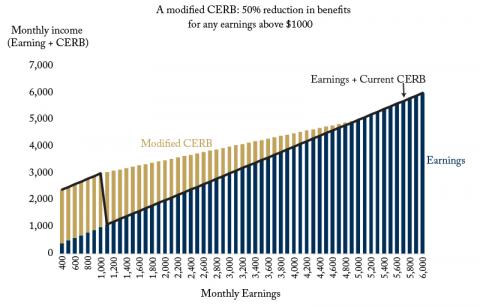From: Tammy Schirle
To: Bill Morneau, Minister of Finance
Date: May 12, 2020
Re: Designing a CERB that supports efforts to re-open the economy
In mid-March, large parts of the Canadian economy needed to shut down. The Canada Emergency Response Benefit (CERB) was quickly introduced, designed as an emergency measure to support Canadians who we needed to stay at home so that we could “flatten the curve.”
In the coming months, however, I envision two problems with CERB.
First, many of the workers first eligible for CERB will run out of benefits in July. Without an extension of the program, or a replacement or complementary program, many will be left without support.
Second, as provinces move to re-open some sectors of the economy where health risks are more manageable, CERB’s design could slow things down, given its poor work incentives.
When thinking about the factors affecting the decision to work, the most important is simply whether a reasonably safe job is available. For many of the businesses shuttered in March, a full re-opening (and hiring back workers) is a long way off. For other workers, health and safety concerns or the unavailability of safe childcare may pose barriers to re-entering the workforce. As CERB was designed to offer benefits for only 16 weeks, workers laid off from some of the most affected sectors will need further support. While some would be able to move into the EI system, many others will be left without support unless an extension of benefits is available.
As some provinces move toward re-opening sectors of the economy where health risks are more manageable, many people are eager to work and the financial benefits of working will become a more prominent factor in work decisions.
For many workers, CERB will affect the financial incentives to work. In CERB’s original design, enabling people to stay at home was a feature of the program. Consider, however, that CERB currently offers a $2,000 benefit and allows workers to earn up to $1,000 in a month before losing their benefits, so that their total potential income from earnings and CERB (before any taxes) is $3,000. If they accepted even one more dollar’s worth of work, they lose the $2,000 CERB benefit and are left with $1,001 to support themselves and their family.
Moving forward, the CERB benefit structure could be slightly modified so that workers able to find work that pays more than $1,000 are better off by doing so, without harming the people unable to find jobs. For example, a base benefit of $2,000 could be offered, with an earnings exemption and a reduction in CERB benefits for earned income above the exemption. If for example we continued with a $1,000 exemption for earned income, and reduced the CERB benefit by 50 cents for every dollar earned over that, workers would continue getting at least some CERB support while earning up to $5,000 per month (see figure).
I see many benefits to this modified CERB design. First, a gradual reduction of benefits for earned income will better support parents who want to share caregiving responsibilities by coordinating partial-return-to-work schedules until safe childcare options are available. Second, for workers without safe job options, support would continue.
If CERB is left to expire, some of the individuals unable to find employment will be able to move into the EI system, receiving up to $573 per week. There are opportunities to earn while receiving EI benefits, with benefits reduced by 50 cents for every dollar earned, until one earns 90 percent of insurable earnings. (As an aside, the marginal effective tax rate on earnings for the EI program, especially when viewed in the full context of the tax and transfer system, is quite high but perhaps unavoidable).
An extension of CERB would be more broadly available to all workers affected by COVID-19. While an extension that accounts for earnings will be more difficult to administer, it is worth determining whether continued benefits are best administered as a CERB extension or the transfer of so many individuals to the EI system.
The CERB extension suggested here offers a relatively generous benefit not available to essential workers. As Luc Godbout has pointed out in a recent memo, we should also take into account fairness considerations. On May 7, the federal government announced an agreement to boost the wages of low-income essential workers which may offer some balance to any extension of CERB benefits.
Finally, it is important to recognize that CERB is not the only policy available to support workers in the transition to re-opening sectors of the economy. The Canada Emergency Wage Subsidy can also support the workers who remain attached to their employer. However, the subsidy only covers wages from March 15 to June 6, although some extension is promised. While the speed at which provinces are able to re-open sectors is uncertain, and will clearly differ across regions, continued management of these supports across the country poses an extraordinary challenge to the federal government.
Tammy Schirle is Professor of Economics at Wilfrid Laurier University, and is a C.D. Howe Institute Research Fellow.
To send a comment or leave feedback, click here.
The views expressed here are those of the author. The C.D. Howe Institute does not take corporate positions on policy matters.






